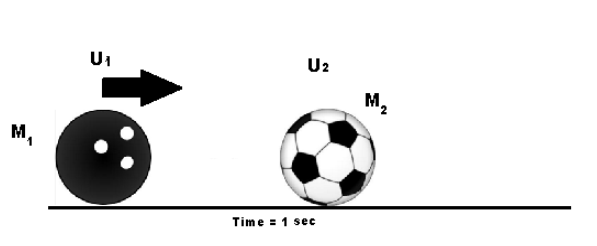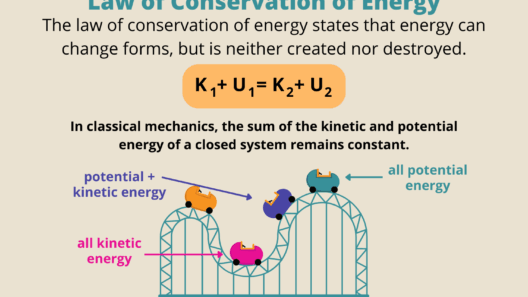Physics, as a branch of science, seeks to elucidate the principles governing motion and energy in our universe. Among its key concepts are the conservation of energy and the conservation of momentum, both of which are fundamental to our understanding of physical interactions. Although they often arise in similar contexts, they are fundamentally distinct principles that illuminate different facets of physical phenomena.
The conservation of energy is predicated on the principle that energy cannot be created or destroyed; rather, it can only transform from one form to another. This tenet is perhaps one of the most revered in physics, underlying everything from thermodynamics to quantum mechanics. In practical terms, when a system undergoes a change—be it kinetic energy morphing into potential energy or thermal energy dispersing into the environment—the total energy of that system remains constant, provided it is isolated from external influences.
For instance, consider a pendulum. As it swings, the kinetic energy at its lowest point is at maximum, while potential energy at its highest point is at maximum, epitomizing the continual transformation and conservation of energy. This oscillatory motion is emblematic of energy transfer, with gravitational potential and kinetic energy alternately dominating as the pendulum moves through its arc.
In contrast, the conservation of momentum describes the behavior of objects in motion, focusing on the total momentum of a system—defined as the product of an object’s mass and its velocity. According to this principle, in an isolated system where no external forces act, the total momentum remains constant through interactions, such as collisions.
Take, for example, an elastic collision between two billiard balls. Upon impact, not only does momentum transfer from one ball to another, but the total momentum before the collision equals the total momentum post-collision. Such principles find application in various scenarios, from spacecraft navigation to automotive safety designs.
Albeit both concepts reflect an invariant quantity in physics, they operate in different dimensions. Conservation of energy primarily concerns the forms and transformations of energy within a system. Conversely, conservation of momentum specifically deals with mass and velocity, emphasizing how bodies interact in motion. This distinction is critical when addressing various physical systems, allowing physicists to predict outcomes with precision.
A common observation that often bridges these two principles occurs during various forms of collisions or interactions. While energy may transform into other forms, as in thermal dissipation or sound production, momentum remains conserved in isolated systems. This apparent discordance between the conservation laws can lead to nuanced misunderstandings, particularly in scenarios like inelastic collisions where some kinetic energy is converted to heat or deformation.
Through real-life applications, we see the elegance of these principles at play. In vehicular safety, aspects of both conservation of energy and momentum are harnessed to enhance design effectiveness. Crumple zones in modern cars, for instance, deliberately deform upon impact, transforming kinetic energy into other forms—thus protecting passengers. This kind of engineering brilliantly showcases our application of both conservation laws: the energy is never lost but redistributed, and momentum changes occur in a controlled manner, keeping the system’s overall motion in check.
When examining the implications of these principles on a cosmic scale, they reveal deeper universal truths. The conservation of energy has implications in the context of thermodynamics and the evolution of stars. As stars burn fuel and release energy, they illustrate the transformation and transfer of energy in colossal quantities, while their trajectories and interactions with other celestial bodies involve considerations of momentum conservation. Understanding these principles helps illuminate not just earthly phenomena but also the fates of galaxies and the universe itself.
These laws of physics extend into the realm of climate science, especially when considering energy transformations in natural systems. One may ponder how conservation laws play roles in the energy exchanges that dictate weather patterns or ocean currents, revealing fascinating insights into climate dynamics that influence our planet’s habitability. Thus, the conservation of energy can be seen as essential in modeling climatic systems, while momentum could be pivotal in understanding ocean currents and their interactions with the atmosphere, intertwining physics with pressing global concerns.
The fascination with these principles lies not merely in their mathematical representations but also in their philosophical implications. They remind us of a universe interconnected and governed by fundamental laws that reflect balance and harmony. The interplay of energy transformations and momentum conservation evokes a deeper appreciation for the intricate designs of nature, urging us to ponder our role within this framework. The study of these principles not only deepens our understanding of the physical world but also enhances our awe for the complexity of the universe.
Understanding conservation laws is paramount in promoting sustainable practices and technologies as societies strive for a future untainted by environmental degradation. Knowledge of energy conservation can lead to innovations that enhance efficiency, reducing our carbon footprints and minimizing ecological impacts. Simultaneously, grasping momentum conservation can aid in the design of green transportation systems that ensure safer, more efficient movement while conserving natural resources.
In summary, while the conservation of energy and the conservation of momentum are distinct principles within the realm of physics, they are interconnected and essential for a comprehensive understanding of the physical interactions in our universe. Whether explaining mundane phenomena or delving into the cosmos, these principles elucidate the realms of energy and motion, intriguing minds and prompting questions about our existence. As we navigate an ever-evolving understanding of our planet and its systems, grasping these fundamental principles becomes more important than ever in tackling the challenges of our day.







